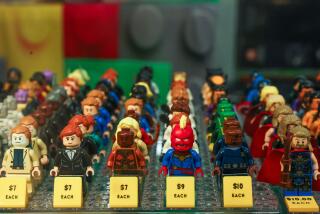With No Must-Have Toy, Bargains Rule
Toy shoppers began lining up at 4:30 a.m. Friday outside the Toys R Us on La Cienega Boulevard in Los Angeles in search of one thing -- and it wasn’t a must-have toy.
Instead, they wanted a bargain.
Claudia Santos, 33, and Rosa Bonilla, 40, came to buy a Game Boy Advance hand-held device, which for $70 included a $30-value Super Mario World game.
Rosa Hernandez, 18, and nine family members came for, among other items, a Nintendo GameCube and software, advertised at $200, or about 17% off. And Jonas and Vivian Calderon, 32 and 29, weren’t sure what to buy for the 21 kids on their shopping list, only that they wanted good prices and a decent selection.
“It’s not any one thing,” Hernandez said. “We just know that every year they have good specials.”
Unlike the traditional holiday toy melee -- with parents pushing, grabbing and driving to 18 stores in search of that one product American children are clamoring for -- there is no consensus this year on a must-have toy.
There are contenders, to be sure. Many retailers are already out of FurReal Friends, Hasbro’s lifelike, battery-operated cats. Rapunzel Barbie had proved a strong seller even before the start of the holiday. RadioShack’s pocket-size radio-control cars, ZipZaps, are running scarce. And educational games also are popular.
But without a clear winner in this year’s toy contest, the race remains wide-open for a share of the $23 billion that Americans are expected to spend this year on non-video-game toys. About 40% of those sales probably will occur during the next 3 1/2 weeks.
Even in the $10-billion video game arena, the sheer volume of new titles this year will make it difficult for any one or two of them to rise above the noise.
“There were a lot of toys -- 10 to 12 -- in the typical shopping cart, and every basket was different,” said Toys R Us Chief Executive John Eyler Jr. after surveying New York-area stores Friday. “That’s less stress on parents, more kids get what they want, and it’s better for business. A group of toys collectively do a whole lot more business than any one toy can do.”
Industry watchers say the trend is good for the nation’s biggest toy manufacturers because parents are inclined to seek out classics when there is no single hot toy on the shelf. El Segundo-based Mattel Inc. and Providence, R.I.-based Hasbro Inc. own the largest number of recognizable names, such as Barbie, Fisher-Price, Milton Bradley and G.I. Joe.
“It’s a time when brands actually have more value,” said M. Eric Johnson, a professor of management at Dartmouth College’s Tuck School of Business and an expert on the toy business. When parents aren’t sure what to get, “they’re going to link into what they know.”
With parents likely to spend more time searching out gifts in the absence of a hot toy, they also tend to turn to retailers with a wide variety of goods, such as Toys R Us Inc. and KB Holdings Inc.’s KB Toys chain.
“The good thing about a hot toy is, of course, that everyone is talking about it and they come in looking for it,” said KB’s chief executive, Michael Glazer. “The bad thing is that you disappoint an awful lot of people” when supplies run out.
“As a retailer,” Glazer said, “you’re frustrated you can’t take care of that customer. Sometimes it’s nicer if there’s a slew” of offerings that kids want.
Still, the phenomenon sometimes can work against the specialty toy sellers. That’s because, without a reason to go into a toy store, some parents will buy things for their children wherever they happen to be.
At the Wal-Mart in Cerritos Towne Center on Friday, Beverly Armstrong, a 40-year-old nurse from Los Angeles, pushed a cart heaping with toys for her 2-year-old grandson, including Hot Wheels and a Spider-Man web blaster.
Armstrong said she was toy-shopping at Wal-Mart because she wasn’t looking for any toy in particular.
“When I’m looking for specific things, that’s when I go to Toys R Us,” Armstrong said. At Wal-Mart, “I can just pick things out.”
Discounters such as Wal-Mart Stores Inc. often offer popular items at a fraction of the suggested retail price to lure shoppers into stores. That’s one reason Wal-Mart a few years ago took the title of the nation’s top toy seller from Toys R Us.
Part of what creates a really hot toy is limited production. When Cabbage Patch dolls, Tickle Me Elmo and Furby were all the rage, manufacturers, retailers and parents were all caught off guard.
“The scarcity was part of the appeal,” said Sean McGowan, a toy industry analyst with Gerard Klauer Mattison in New York. “You could convey the social status of your children by procuring one.”
Small companies can put themselves on the map with a hot toy. And the lure of creating the next big thing is one of the attractions that keep inventors and other innovators coming back to the toy design table, said Dartmouth’s Johnson.
But for most companies, having the hot toy may not be worth the hype, Johnson maintained.
“How many hot toys can you think of that were really turned into a franchise, that five years later someone was really making money on?” he said. “They weren’t able to take Furby and turn it into something like Barbie.”
Of course, the biggest beneficiary of not having a must-have toy might be parents, who can avoid horrendous lines, hassles and potential heartache when something is sold out.
Toy buyers probably shouldn’t count their lucky stars just yet, those in the industry say. A few years ago, Tickle Me Elmo was being discounted just before Thanksgiving -- and then took off like a rocket after the holiday after an appearance on a morning news show.
“Parents still may get to the stage of hair pulling,” McGowan said. “We don’t know what it is, but if the stores don’t have enough of it, parents will become desperate pretty quickly.”
*
Times staff writers Alex Pham, Stephanie Stassel, Jia-Rui Chong and Hilda Munoz contributed to this report.
More to Read
Inside the business of entertainment
The Wide Shot brings you news, analysis and insights on everything from streaming wars to production — and what it all means for the future.
You may occasionally receive promotional content from the Los Angeles Times.










